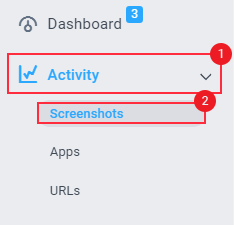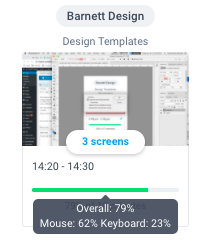How are activity levels calculated?
How are Activity Levels Calculated in Clockbook?
Activity levels in Clockbook are calculated based on the percentage of keyboard and mouse strokes over the total time tracked for a specific time period. The activity levels feature lets you know exactly how productive you or your team are when tracking time. You may use this data to quickly address team efficiency on the spot.
Viewing Activity Levels
- STEP 1
Navigate to Activity > Screenshots.

- STEP 2
Toggle the Activity page view to Every 10 min:
![]()
- STEP 3
Under each 10-minute segment, you’ll see an activity bar:

Calculating Activity Levels
Below is Clockbook calculates activity levels:
-
For every second, we label the user as active or inactive. A mouse movement or keyboard stroke = active. No keyboard or mouse = inactive.
-
We add all of these numbers up and give a total % of activity for that 10-minute segment using this equation: Active seconds / 600 = activity rate %
-
Also, we track if the user was active or not. By default, 20 minutes without inactivity triggers an inactive status, in which case the desktop client gives the contractor the option of removing that time from their log because they were inactive.
Here’s an easy way to think about how we calculate activity rates:
If you have 100 seconds of tracked time, and 20 seconds of idle time (no mouse or keyboard movement), you’d have an 80% activity rate.
Those 100 seconds might look like this:
| Mouse | Keyboard | No Activity | Total Activity | |
|---|---|---|---|---|
| 20 seconds | Yes | 20 | ||
| 35 seconds | Yes | Yes | 35 | |
| 15 seconds | Yes | 15 | ||
| 20 seconds | Yes | 0 | ||
| 10 seconds | Yes | 10 | ||
| 80 seconds or 80 activity out of 100 seconds |
80% overall activity rate
Because 80% of the 100 seconds were spent using the mouse or keyboard.
What activity rates mean
Depending on someone’s job and daily tasks, activity rates will vary widely.
Jobs involving data entry, design, development, and other high mouse and keyboard activity will tend to have higher averages.
Team members who spend more time in meetings, doing more research, or participating in video chats will tend to have lower scores. It makes sense; they’ll be moving their mouse and keyboard less if they’re primarily talking or reading.
That’s why people with 75% scores and those with 25% scores can often times both be working productively. If a usual day for your team involves checking email, reading articles, or having calls with one another, they might have an average activity rate of around 50%.
Instead of using activity rates as a one-time snapshot of productivity and making a decision based only on them, our recommendation is to use these as trends.
Look for patterns, and if a continually declining activity rate shows up, have conversations. The idea of activity rates is to keep a dialogue going and improve processes and workflow over time.
At Clockbook, we discourage the use of quotas or scoring based on activity rates. Frustration can emerge when managers and team members aren’t clear on what’s expected of them, so an open dialogue can keep work moving.
Clockbook does NOT store individual keystrokes that are entered (there is no keylogging) or where your mouse clicks. We simply track the number of seconds we detect keyboard or mouse activity which includes mouse move, mouse click, mouse wheel, and keyboard presses. We don’t store specifically what was done, only that there was some activity during a second.